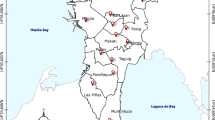Abstract
Goal, Scope and Background
Atmospheric sampling (gas and particles) of 5 phenols (phenol, m-cresol, p-cresol, o-cresol, pentachlorophenol) and 15 nitrophenols (3-methyl-2-nitrophenol, 3-nitrophenol, 4-methyl-2-nitrophenol, 5-methyl-2-nitrophenol, 2-methyl-3nitrophenol, 3-methyl-4-nitrophenol, 2,6-dinitrophenol, bromoxynil, 2,5-dinitrophenol, 2,6-dinitro-p-cresol, 2,4-dinitrophenol, ioxynil, DNOC, 3,4-dinitrophenol, dinoseb) on XAD-2 resin (20 gr) and glass fibre filters, respectively, were performed in 2002 by using 'Digitel DA80' high volume samplers. These measurements were undertaken in order to show spatial and geographical variations of concentrations and the role of traffic in the emissions of these compounds to the atmosphere.
Methods
Sampling were performed in Strasbourg (eastern France), in its vicinity (Schiltigheim) and in Erstein. Sites were chosen to be representative of urban (Strasbourg), suburban (Schiltigheim) and rural (Erstein) conditions. Field campaigns were undertaken simultaneously in urban and suburban sites during all the seasons during 4 hours at a flow rate of 60 m3.h-1, which gives a total of 240 m3 of air per sample. Period of sampling varied between 06h00 to 10h00, 11h00 to 15h00 and 18h00 to 22h00 in order to evaluate a variation of concentration during automobile traffic between urban, suburban and rural areas. Gas and particle samples were separately Soxhlet extracted for 12 h with a mixture of CH2Cl2 / n-hexane (50:50 v/v), concentrated to about 1 mL with a rotary evaporated and finally dried under nitrogen. Dry extracts were dissolved in 1 mL of CH3CN. Before analysis, extracts were sylilated by using MTBSTFA. Analysis was performed by GC/MSD in the SIM mode.
Results and Discussion
Partitioning of phenolic compounds between gas and particle phases seems to be mainly correlated with vapour pressure. Among phenolic compounds analysed, phenol, p-cresol, pentachlorophenol and 2.4-dinitrophenol were detected in all samples and emissions from traffic seems to be the major source for the presence of these compounds to the atmosphere. No increase of concentrations in autumn tend to confirm this hypothesis since, with the use of domestic heating in colder months, increases of PAHs concentrations were observed and these compounds are known to be emitted by all combustion processes. Pentachlorophenol is a special case since this molecule is only used as wood preservative. Its presence in all atmospheric samples, whatever the locations and the period of time is the consequence of its persistence.
Conclusions and Perspectives
These measurements demonstrate that phenols and nitrophenols are emitted to the atmosphere and further measurements, in order to confirm their sources, their behaviour and their potential impact to the air quality and to human health should be undertaken especially since the literature collected is relatively old. Concentrations of pentachlorophenol measured are very low and, due to its toxicity, further investigations should be undertaken.
-
* The basis of this peer-reviewed paper is a presentation at the 9th FECS Conference on 'Chemistry and Environment', 29 August to 1 September 2004, Bordeaux, France.
Similar content being viewed by others
Author information
Authors and Affiliations
Corresponding authors
Rights and permissions
About this article
Cite this article
Morville, S., Scheyer, A., Mirabel, P. et al. Spatial and Geographical Variations of Urban, Suburban and Rural Atmospheric Concentrations of Phenols and Nitrophenols (7 pp). Env Sci Poll Res Int 13, 83–89 (2006). https://doi.org/10.1065/espr2005.06.264
Received:
Accepted:
Published:
Issue Date:
DOI: https://doi.org/10.1065/espr2005.06.264




